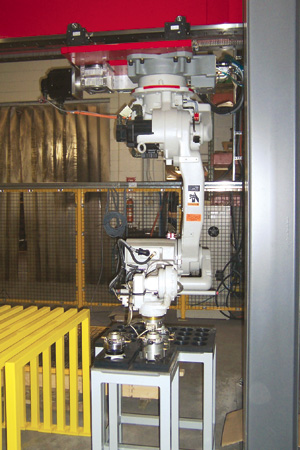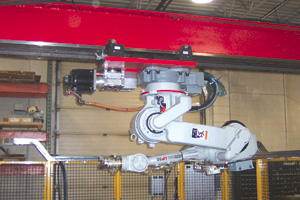
Integrating safety: Examining the benefits of a safety PLC
June 15, 2006
By Adam Mullis
The changing environment of safety compliance and enforcement has increased the attention that manufacturers give to safety in their plants.
Today, there are critical legal issues involved. New federal laws extend the liability of criminal negligence to all knowing persons, furthering the legal duty of everyone who works within the manufacturing corporation to act upon safety issues. Under the General Duty Clause (Sec. 25(2)(h)) of the Occupational Health & Safety Act, employers are required by law to protect workers from serious and recognized workplace hazards. Even in those few cases where there are no standards for adherence, employers must take action to eliminate these hazards. In addition, to ensure compliance, the Ministry of Labour has hired 200 more inspectors.
Beyond these legal requirements, there are cost and productivity issues at play. In Business Results Through Health and Safety, a publication produced in partnership between the Canadian Manufacturers and Exporters Association and the Workplace Safety and Insurance Board (WSIB), it was reported that the average lost-time workplace injury costs more than $59,000 (including claim costs, repair, lost production and management time, higher WSIB fees, and lower productivity during recovery). The indirect costs associated with workplace injury make up more than three quarters of the total costs.
With all of this in mind, manufacturers are looking beyond basic safety compliance. The buzzword which embodies the current trend in safety solutions for manufacturers is the concept of “integrated safety” — the incorporation of process control and safety control systems. At the forefront of these solutions is the safety PLC.
The safety PLC is a critical part of the overall integrated control system. It falls into two main application groups — fail-safe and fault-tolerant. Fail-safe applications, also called safety protection systems, are used primarily in general manufacturing to shut down machinery and put it into a safe state. Fault-tolerant applications, appropriately called safety continuous control systems, are required for process-related applications to keep the process running through fault conditions where a shut-down would create a dangerous situation (e.g. chemical spill) or significant loss of product. Fail-safe applications are more commonly considered for safety solutions.
Opportunities
The clearest benefits for using safety PLCs relates to cost. Especially for new machines developed by OEMs, the controllers can reduce direct labour costs for wiring, testing, installation and programming. Codes written can often be reused from one product solution to the next with minimal changes. As the controllers are often priced 25 to 30 per cent more than standard PLCs, a holistic approach to integration can play a larger role. By integrating safety and control functions, it reduces or eliminates the need for duplicate PLCs and capitalizes on the associated costs for related safety-rated fieldbus networks in the plant. Independent standards, like IEC 61511 and 61508 or ANSI/ISA 84.00.01, when followed, can resolve possible issues and thus maintain safety integrity levels while providing manufacturing control.
Another advantage of the controller is reduced downtime. Consider the time difference between troubleshooting a panel that has a safety PLC installed with minimal wiring and diagnostic capabilities versus a panel that utilizes only traditional relays, numerous metres of wiring and little or no diagnostics. Potential downtime can be prevented as the simplified wiring avoids many of the installation trip-ups that can occur and allows maintenance a fighting chance of trouble-shooting problems. As well, the controller program can be security-protected to restrict access to change the program code. Overall, these can have a direct impact on a plantÃs overall equipment effectiveness.
Consider one line that has three cells with 14 robots, four or five safety gates, between four and six light curtains, lots of E-stops, safety contactors, and each robot has joint one safety position switches. This represents a total of about 200 input and output points. With this large number of input and output points, and possible safe/unsafe positions, a safety PLC is more cost effective and minimizes future potential downtime. I/O data can be passed to a main line processor for troubleshooting and HMI display. This solution can also achieve a Category 4 safety level through the use of pulse testing ó a method where output signal is sent from a safety PLC through field safety components and received back as input at exact pulsed intervals.
For applications that demand flexibility, a safety PLC can provide certain key benefits. New components can be added and line changes can be made easily to an existing system. Modifications to the system can be made with relative ease to accommodate changing Pre-Start Health and Safety Review (PSR) assessments. This flexibility extends to the initial system design where the PLC can meet the needs of even complex systems.
A good example of a flexible solution was completed for Mold-Masters, where the safety PLC was chosen to meet rigorous design demands and allow for continuous process changes and upgrades. The system included two robots travelling on a 32-metre overhead rail through five safety zones. In addition to having control of safety gates and E-stops, the biggest challenge was to monitor the position of each robot with the safety PLC as each robot operates in two separate safety zones plus one shared middle zone. The solution required three pairs of safety switches on each robot to continuously monitor the position of the robot in each zone. As well, each robot was given three more pairs of switches to monitor joints one, two and three, which permitted monitoring of its proximity to the safety guarding during automatic operation. To ensure that each robot is constantly a safe distance from operators, different combinations of safety switches to cover all possible safe and unsafe positions for robots and operators needed to be created in the safety PLC logic — a solution that would be next to impossible using just safety relays and wiring.


CONSTRAINTS
Interestingly, one of the major benefits of a safety PLC is also one of its drawbacks: cost. For older machines, established control networks or smaller projects, often the costs for a safety PLC are unwarranted. This is especially true when other options are available that can provide similar benefits. A good option to consider is a connection system. A connection system is a hardware-based system that focuses on using a combination of distribution blocks and cabling to eliminate the need to run the standard six wires (two channels plus annunciation) between each field device. Depending on the application, it can minimize wiring, reduce panel space requirements and provide local control.
A connectivity-type solution was implemented for Indalco Alloys for a safety upgrade on 19 machines of three major types, each with an average of four E-stops and three gate interlocks. Indalco had little space available in its existing panels, as well as little space for new panels elsewhere in the plant. The company had a moderate amount of hard-wired controls in addition to networked control using small logic controllers. The control programs in place had been changed numerous times since original installation, so the safety solution needed to minimize interference with the existing controls and HMIs. As a result, a safety solution was designed to essentially fit on top of the machines. The connection system reduced wires back to the panel by as much as 70 per cent, meaning that significantly smaller auxiliary panels could be used, and in some cases eliminated. Stack pole beacons indicated “E-stop Violated,” “Gates Open” or “System OK,” and annunciation on the field devices themselves was used to locate which specific device was not ready. The entire solution design met the required Category 3 safety rating.
There are several other factors to consider before deciding whether to use a safety PLC solution. There are trade-offs to achieve some of the noted cost savings. Typically the components are more expensive leading to an increased cost to maintain spare parts onsite. Additionally, safety PLCs are more complicated in program design. Appropriate personnel need to know how to troubleshoot the software. It is not like standard safety solutions where they can just go through the wiring relay to uncover issues and failures.
THE HOLISTIC SAFETY APPROACH
Before acting upon a PSR or risk assessment, it is critical to develop a thorough safety strategy for the project that works within the context of your company-wide safety plan. Sufficient review of functional impact areas results in the execution of appropriate solutions with minimal extra costs. It allows for a migration towards integrated plant safety that will ultimately be less expensive, make effective use of modern safety technologies and provide a safer environment for employees.
Adam Mullis is a group manager with JMP Engineering in London, Ont.
Advertisement
- ROBOTICS Q&A – A conversation with Trevor Jones
- On guarding: What you need to know about employee safety and machine safeguarding